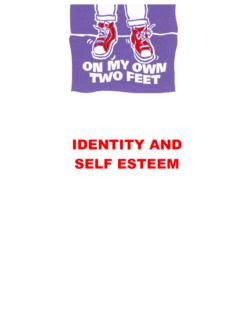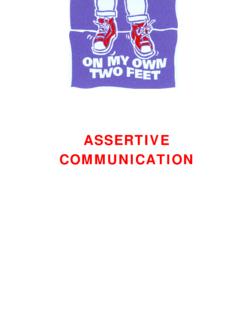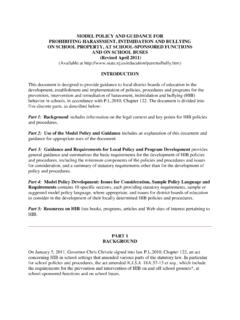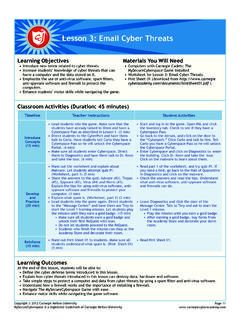Transcription of Responding to Bullying - sphe.ie
1 Responding to BullyingF i r s t s t e p s F o r t e a c h e r sThe Cool School Programme1 Contents IntroductionWhy pupils don t tellWhen pupils tellWhat can you do if a pupil tells you that he/she is being bullied?ListenTake notesReassure and supportEnsure the pupils safetyNegotiate confidentialityKeep the young person informedMake an intervention Decide who to consult Decide who to interviewResolve the problemMake a recordSample Bullying Record FormReferencesSuggested ReadingContact details233444555566679101111122 IntroductionThe Cool School Programme is an anti - Bullying Initiative for Post-Primary schools developed within the North Eastern Health Board s child Psychiatric Service. It is supported by assistance from the Health Promotion Unit, and the In-Career Development service of the Department of Education and multi-disciplinary team is engaged in this work, comprising a Consultant Psychiatrist, a Principal Social Worker, a Research Psychologist, and two Teachers.
2 The impetus for partnership between Health and Education in this initiative arises from the significant effects Bullying has on the wellbeing of young people, and on their progress in school. Significantly, these effects can also last into adulthood, causing depression and poor social development. They include: physical injury, headaches, stomach aches, stress symptoms such as sleep problems, eating disorders, anxiety or panic attacks, and loss of confidence and self-esteem. In very extreme circumstances some young people even consider suicide. In school terms the effects are likely to include: drop-out, truancy, school refusal, low academic achievement or complete failure, exclusion and isolation. The Programme aims to provide a support service for schools to facilitate implementation of the Department of Education s Guidelines on Countering Bullying in Primary and Post-Primary Schools. Consequently, elements of the Cool School Programme include, whole school policy development, teacher training, development of materials, and group therapy for victims of Bullying .
3 A research component investigating Bullying behaviour is also booklet offers advice for teachers on how to proceed if a young person takes the very brave step of asking for help. Given the atmosphere of fear and secrecy which surrounds Bullying , and the fact that adult intervention is almost always necessary to stop it, it is crucial that the confidence placed in a teacher by a pupil is reciprocated by an unequivocal response. The guidelines therefore, offer a structured way of providing support which is teacher friendly, while at the same time covering the main issues pupils don t tellRecent research in Ireland shows that most children will not tell adults that they are being bullied. In post-primary schools, 84% of victims said they had not told their teachers, and 66% did not tell anyone at home (O Moore, et al 1997). A survey of over 1000 post primary students in the North Eastern Health Board area shows that only 46% of victims had told a teacher, and 33% had told a parent (James et al, submitted for publication).
4 The following are some of the fears, feelings, and beliefs of young people in relation to telling: That the Bullying will get worse and spread to a wider group because they have told. Teenagers are particularly vulnerable to the ridicule and ostracism inflicted on people who have ratted . Many pupils find it difficult to distinguish between telling to keep safe, and ratting . Physical threats may have already been made, and they are anxious about retaliation. They will feel even more intimidated if there is a gang involved. They may be worried about an adverse reaction from their parents, and feel shame that they can t stand up for themselves . They don t want to be seen as somehow failing their parents, or admit that they are unable to cope with school. A feeling that they deserve the Bullying , and the guilt accompanying this, is often a factor. Many victims simply lack the social skills and confidence to come forward.
5 Sometimes approaching an adult about a problem, especially a teacher, may seem too daunting a prospect for a timid or anxious pupil. Many victims believe that nothing can be done about the Bullying , and in schools where the anti - Bullying ethos is weak, they may believe that nothing will be done. If they are unaware of previous successes of staff in relation to handling Bullying incidents, they may not feel confident about the school s ability to intervene. Given the reluctance to tell, it is important that teachers take a pro-active roll in investigating whether Bullying occurs within their pupils tellAny pupil who discloses Bullying is expressing a cry for help which needs a robust response from the teacher they have chosen to tell. A bullied pupil may pick any teacher to be their first confidant, so it is worthwhile for all staff members to be familiar with the basic steps for providing support.
6 In schools where active anti - Bullying measures and procedures are well established, young people will be more likely to come forward and ask for help. In certain cases, pupils will disclose Bullying to a teacher simply to relieve the pressure and for moral support. 4 What can you do if a pupil tells you that he/she is being bullied?1. ListenThe very act of telling someone about Bullying can be therapeutic in itself, so being available to listen is the first step in supporting the victim. Allow the bullied student time to tell their story in their own calm and objective, avoid displaying shock or disbelief, and accept what is said. The privacy of an office will allow the young person to de-stress, and encourage them to be more forthcoming with details. Alternatively, an empty classroom could be used. Having a colleague present is usually recommended if possible, although some pupils may insist on talking to a teacher alone.
7 A useful strategy in this case would be to leave the door open so that the teacher can be seen by passers-by, while the victim of Bullying remains unseen inside the Take notesThese will form the basis of a report for dealing with the incident, and can be kept on file as part of the School s Bullying records. (See section 6).Include details such: nature of the incident, date, time, location, names of those involved, names of witnesses, any other relevant history and the teacher s response. 53. Reassure in the following wayThe young person needs to be told that: Help is available. Action will be taken to stop the Bullying . Telling is praiseworthy, because this is the most important step in getting the Bullying stopped. Bullying can happen to anyone, and nobody should have to put up with it. It is not your fault . There is nothing wrong with you . You do not have to face this on your own .4. Ensure the pupil s safetySatisfy yourself that the pupil is not in immediate danger of physical assault.
8 If there is a risk, parents can be asked to collect the pupil from school, or arrangements can be made to keep the potential assailant from carrying out an attack. Schools would also need to ensure supervision if the young person s safety has been Negotiate confidentialityDiscuss that in certain circumstances you might need to talk to the pupil/s involved in the Bullying as well as parents, witnesses, other teachers, or the school management, as appropriate. Explain that you will tell only the people who need to know, and give a reason why they have to be told. Be clear about how you will build in safeguards for the victim s safety and privacy where possible. For example, the young person can be told that persons interviewed about their involvement can be warned not to retaliate, or spread gossip, and that you will be checking up on Tell the young person that you will keep them informed Let them know how you are going to proceed, and how you will keep them Make an Very serious cases should be referred to the Principal straight away.
9 For example pupils who are being bullied on a regular basis, pupils who are very badly distressed or despairing, or pupils who have been Decide who to consultBe clear what your school s procedure is, because structures and supports available vary from school to and advice may be forthcoming from the following: Class tutor Year-head anti - Bullying Co-ordinator or Team Management School counsellor Parent/s of victim Parent/s of bully Outside agencies (eg, Educational Psychologist, Gardai).Once you have consulted the appropriate person/s in your school, the following guidelines may inform your next Decide who to interview Witnesses (Primarily other pupils, however teachers or other staff may also be in a position to help). Alleged bully or bullies. It may also be helpful to speak to pupils who are not involved. Their contribution may be unbiased and may add perspective to the situation. A useful question to ask in this context- Is anybody in your class getting a hard time?
10 Seek answers to: What? Where? When? Who? Why? How? Take a calm, unemotional, problem-solving approach. Deal with conflict in a non-aggressive, non-confrontational manner. 7C. Resolve the problemVictim and BullyMany Bullying incidents can be resolved by explaining to the bully what is wrong with their behaviour, and how it is affecting the other person. In the vast majority of cases an agreement to stop, and an apology to the victim will be forthcoming. Bringing the different parties together to achieve a reconciliation can have a very positive outcome for both and BullyIn cases where the Bullying requires the imposition of sanctions, the co-operation of parents is crucial. The school s policy on Bullying , and code of discipline need to come into play, particularly where the safety of other children is at risk. Agreement should be sought from parents and the pupil responsible in relation to future and PrincipalIn the case of a very resistant bully, planning steps to intervene may take more time.











